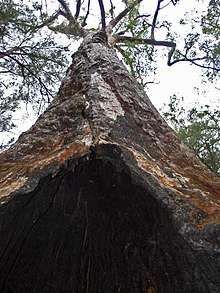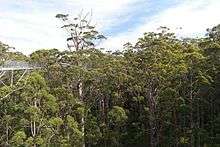Eucalyptus guilfoylei
| Yellow tingle | |
|---|---|
 | |
| Scientific classification | |
| Kingdom: | Plantae |
| Clade: | Angiosperms |
| Clade: | Eudicots |
| Clade: | Rosids |
| Order: | Myrtales |
| Family: | Myrtaceae |
| Genus: | Eucalyptus |
| Species: | E. guilfoylei |
| Binomial name | |
| Eucalyptus guilfoylei | |

Eucalyptus guilfoylei, commonly known as yellow tingle or dingul dingul,[1] is a species of tree native to Western Australia.[2] It will often grows up to 40 m tall, with a diameter up to 1 metre.[3] but can grow as tall as 60 m (197 ft).[4] It is rarely harvested for timber, but has previously been used for sleepers, poles or bridge timbers.
Description
The tree typically grows to a height of 5 to 40 metres (16 to 131 ft) and has rough, short-fibred and crumbly bark.[5] The bark is persistent to smaller branches, stringy, red-brown or grey-brown, grey-brown or brown in colour. The dull green discolorous leaves disjunct, lanceolate or broad lanceolate and basally tapered or basally rounded.[4] It blooms between November and January producing white-cream flowers.[5] The inflorescences are axillary and terminal with panicles, they are seven flowered with flattened penduncles, typically 1 to 2 centimetres (0.39 to 0.79 in) in length. Fruits are shortly pedicellate to sessile, approximately 0.7 to 1 cm (0.28 to 0.39 in) long and wide with a pyriform to globular shape. They contain flattened saucer shaped red-brown seeds.[6]
Although closely related to the other tingle trees, Eucalyptus brevistylis and Eucalyptus jacksonii, the trunk of E. guilfoylei is not buttressed, the bark is persistent, the wood is yellow and all leaves are discolorous. All the Tingles are able to reach 400 years of age.[6]
The heartwood is hard and straight-grained with an oak-like yellow colour. The wood has a green density of about 1185 kg/m3 and an air-dried density about 990 kg/m3.[3]
Distribution
Found on slopes and ridges in coastal areas of the Great Southern region where it grows in gravelly loam soils.[5] Found between the Deep and Frankland Rivers west of Albany, on slopes and ridges of hilly country. It occurs as scattered trees in forested areas associated with other large trees, such as Eucalyptus diversicolor, Corymbia calophylla or Eucalyptus jacksonii. The yellow tingle grows best in deep red loamy soils originating from basalt and dolerite but will grow in light loams from granite and schists.[3]
The species was reported as occurring with several plant species, often as the understorey of the E. jacksonii, which is distinguished by its larger size, more fibrous bark and the name red tingle tingle (a variation of a common name, as 'yellow tingle tingle', was also once in popular use for this species). Other associated trees include river banksia and Agonis flexuosa. The tree resembles jarrah but for its less rough bark and light brown wood.[7]
Classification
The species was first described by the botanist Joseph Maiden in 1911 in his article Notes on Western Australian eucalypts, including description of new species. in the Journal of the Natural History and Science Society of Western Australia.[8] The samples were collected by A. Murphy in 1905 near Denmark.[4] The name honours W. R. Guilfoyle, who once was the Director of the Botanic Gardens in Melbourne.[6]
See also
References
- ↑ "Eucalyptus guilfoylei Dingul Dingul". Nindethana. Retrieved 20 January 2017.
- ↑ Australia, Atlas of Living. "Eucalyptus guilfoylei : Yellow Tingle | Atlas of Living Australia". bie.ala.org.au. Retrieved 1 October 2015.
- 1 2 3 "Forest Products Commission - developing the sustainable use of the States plantation and native forest resources in Western Australia". www.fpc.wa.gov.au. Retrieved 1 October 2015.
- 1 2 3 "Eucalyptus guilfoylei Maiden, J. Nat. Hist. Sci. Soc. Western Australia 3: 150 (1911)". Eucalink. Royal Botanic Garden, Sydney. Retrieved 20 January 2017.
- 1 2 3 "Eucalyptus guilfoylei". FloraBase. Western Australian Government Department of Parks and Wildlife.
- 1 2 3 Douglas J. Boland; Maurice William McDonald (2006). Forest Trees of Australia. CSIRO publishing. p. 276. ISBN 9780643069695.
- ↑ Lane-Poole, C. E. (1922). A primer of forestry, with illustrations of the principal forest trees of Western Australia. Perth: F.W. Simpson, government printer,. p. 58.
- ↑ "Eucalyptus guilfoylei Maiden Yellow Tingle". Atlas of Living Australia. Global Biodiversity Information Facility. Retrieved 19 January 2017.